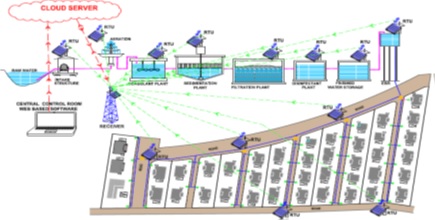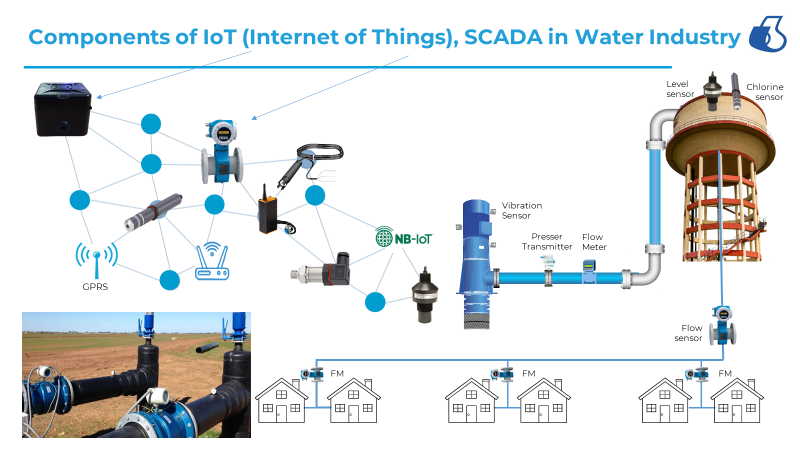By Dilip Yewalekar and Manisha Kinge, Jain Irrigation Systems Ltd, Jalgaon India
Introduction
Till the end of 19thCentury, the Central/State Government, Environment and Pollution Control Board were not so active and serious in controlling, monitoring, and implementing laws and regulations on pollution and the environment for industries, municipalities, and corporations, in India to dispose of& treat liquid and solid waste in a systematic way without creating additional waste in a scientific.There was not much awareness / public domain available on the use of TWW water for landscape, green belt, and agriculture. It is a common trend followed by many industries, municipal councils & corporations, effluent water is simply being disposed of without treatment into a subsidiary of streams or rivers without further thought and caring about the side effects of polluting down streams. The most live example is the Holly River, Ganga & Yamuna called ‘Victim Rivers’ by man-made pollution as a live learning example!
Recently, many countries have taken initiative to implement wastewater treatment and reuseit for landscape, gardens &agriculturalpurposes. Glasgow, 10th Nov 2021-The UNEP, and India signed an agreement on climate change and committed to achieving the target of SDG 6.3. Since 1980, India has initiated the treatment of wastewater and re-use for irrigation of lawns, gardens, landscapes, and forestry at Chennai Municipal Corporation. Many research institutes e.g. Indian Agricultural Research Institute, Karnal, University of Agricultural Science, Dharwad, have carried out research work on the use of TWW for agriculture purposes. Now State/Central Governments are tightening norms and making it mandatory to implement Waste Water Treatment and reuse TWW (Treated Waste Water) for Landscapes, Gardens, Green belts, and agriculture. The sad thing is, still many industries have a hesitant mindsettoward using TWW instead of fresh water and are following theconventional/crudemethods of irrigation to maintain greenery.I saw a message on the hoardings/wall while traveling to Delhi, Mumbai, and Hyderabad, ‘Harit Mumbai, Harit Delhi (keep city green)…..’! There is no meaning in it without using TWW.The said article fosters the industrialist, municipal councils, and corporations to consider to use of TWW to maintain greenery around and highlighted the basic orientation.
Landscape!
Landscape, first recorded in 1598, was borrowed as a painter’s term from the Dutch during the 16th Century when Dutch artists were on the verge of becoming masters of the landscape genre. The Dutch word landscape had earlier meant simply region.
Landscaping involves the planting of ornamental trees, shrubs, vines, ground cover turf, lawn, perennial flowers, annual flowers, bulbs, and other materials for a decorative and aesthetic look.
The aim of landscape is not made to achieve yield or generate commercial income. The overall purpose of the landscape is to add beautifications to the property as well as to protect & maintain the environment and natural flora & fauna, to solve the problem of waste water disposal.
Irrigation for Landscape, Green Belt.
High resources and budgets are being directed for the establishment of good landscapes and gardens at residential, municipalities, factories, corporate, commercial complexes, airports, high-way et,c. Although by concept, it looks very simple to understand, it is a very vast and important subject,and lack of awareness has resulted in a crude way of landscaping, unorganized irrigation, and management. Misconceptions and doubts are still rising in the mind of many people about using TWW for a landscape like bad odor, change in colors, emission of foul smell, toxicity in plants, and unhygienic. If you look at Plant physiology, all plants act as a chemical processing factory where poor-quality water gets processed and used by the plant for metabolic activities. Take the example of coconut plants which are cultivated around the coastal area using seawater but we don’t find salty sea water in coconut.
What is a landscape Irrigation System?
The landscape irrigation system is a combination of the different irrigation systems as suitable for various crop covering and requirements.
• Dripper System.
• Integral Dripline System.
• Sprayer – Micro Jet/ Micro/Mini Sprinkler System.
• Pop Up Sprinkler System.
• Fogging/Bubbler System.
Dripper Irrigation System
In this system, drippers are fixed on blind polytube at designed spacing near to crop root zone and are generally suitable for trees, pot plants, gallery plants, terrace gardening, roadside trees, and fence trees.
Integral Dripline Irrigation System
Drippers are inserted in the tubing at certain intervals during the process of manufacturing in the factory. It forms a continuous wetting strip in the soil and is suitable for irrigation of closely spaced /row plants, shrubs, flowers bed, vegetables, and ornamental plants. It can be placed underground and not visible on the surface.
Micro Jet System
It is a tiny fountain, that sprays water at low pressure in fine droplets and in different patterns- half circle, full circle, square & rectangular, butterfly, strips and looks very attractive. It is suitable for front flower beds, shrubs, and islands of bamboo, ornamental flowers & cactus.
Micro Sprinkler System
It sprinkles water in find drops in a circle and looks very attractive. It is suitable for lawns, flower beds, shrubs, and nurseries and is also used for cooling terraces or balconies during summer.
Pop Up Sprinkler
It is one type of sprinkler, installed on the ground surface (flushing) surface and cannot be seen by normal eyes. While working nozzles come out (pop up) and spray water around and look beautiful. It is suitable le for the front lawn, playground, marriage lawns, and party lawn.
Fogging/Misting
It creates a beautiful effect of artificial cloud, mist/fog without wetness. It also helps to cool down the temperature during summer. Droplet size is less than 100 microns,Nowadays it is also used for cooling purposes during marriage functions at the entrance of doors, and windows. Perfumes are added to spread the fragrance.
Principle Components of Landscape Irrigation System.
Principle components are Control Head Unit (Filtration Unit), Piping Distribution network, Emitting Devices (Drippers, sprayers, micro jets, micro/min sprinkler, pop-up sprinklers), and control units.
Control Head Unit
It consists of a filtration system, a control unit, and pressurizing mechanism (pump unit). Based on the presence of the physical impuritues in TWW, the filtration system is being selected s additional security to while using TWW. Backwashing/Cleaning can be done manually as well as automatic option with the logical program.
In general three types of filtration system are used. Viz.
a. Hydrocyclone
b. Sand / Media filter.
c. Screen / Disc filter
a. Hydro Cyclone filter
It is the first primary filter unit used in a series of filtration groups, used to separate fine silt, solid heavier particles present in raw water before going onward. It works on the principle of centrifugal force and a vortex of water is created to settle down heavier particles into the settling tank.
b. Sand / Media filter
It is the second filter unit in a series of filtration groups, silica media of size 0.7 mm -1 mm is used and it works on the principle of multi-dimensional flow, thereby algae, fine particles, silt, and suspended particles separate to 100 microns rapidly. Back washing/cleaning can be done manually as well as an automatic option with a logical program.
c. Disc filter
It is a 3-dimensional flow filter. Plastic cross-grooved discs are arranged together to form filtration mesh, used to separate remaining particles passed after the sand filter. It can be cleaned manually as well as an automation option with a logical program.
d. Screen filter
It is a 2-dimensional flow filter. It can be made of plastic or metal with stainless steel screen of 100microns, used to separate left-out particles from the earlier filter. It is the last filter in series of filtration unit. It can be cleaned manually or automatically with a logic program.
Controller
It is a microprocessor controller where input data can be processed to get desired work done and desired out-put. It takes control over the operation and no need of extra man power to operate entire system. It just follows instructions as per the program and does the work sincerely in time with messages & alarm.
Piping Distribution network
A piping distribution network can be formed from the TWW storage tank to the field as per the design requirement of the irrigation system. It can be of Pvc / HDPE depending upon the quality of water. It is recommended to use HDPE pipes for irrigation purposes with TWW. The size and pressure rating of the piping network is determined by water flow capacity and frictional head losses by hydraulic engineering theory.
TWW standard Norms (PPCB)
The user should have prior information on TWW supply and its quality as per Table 1 for reference to ensure the formulation and adoption of an appropriate greenery management strategy.
Emitting Devices
Emitters in the form of drippers, sprayers, micro jet, micro sprinklers, pop-upsprinklers, misters, and foggers are selected as per the crop requirement, quality of water, aesthetic aspects, available resources, topography, power available, and facilities.
Benefits of TWW used for irrigation of greenery.
- Since ETP/Water (TWW) is being used for greenery, means pollution and disposal problems get solved to a great extent.
- Because of greenery, the natural cooling effect is generated, and there by energy conservation in using air conditioners can be reduced by 5-20%.
- Countless enjoyment is given to the owner and residents.
- Attractive and aesthetic views are pleasing to users.
- Plantation conveys warmth, protection, and comfort.
- Players & viewers can enjoy games like football, volleyball, and cricket.
- Maintaining freshness and a pleasant environment.
- Time and money put into establishing a nice landscape pay dividend while selling.
Conclusion
Greenery protects our environmentfrom global warming and pollution. And the true fact is that without irrigation (water) greenery is not possible. TWW is the best way to maintain greenerywhile helping to minimizepollution, the environment, and global warming.





